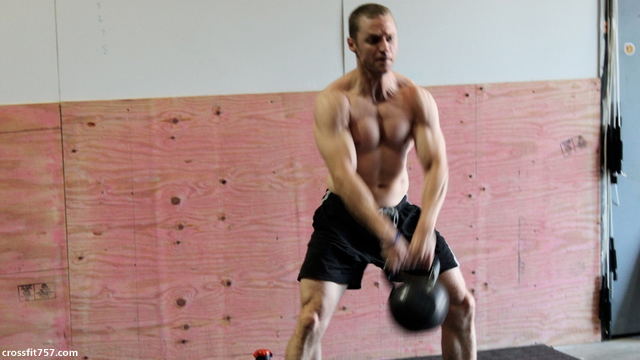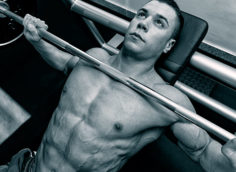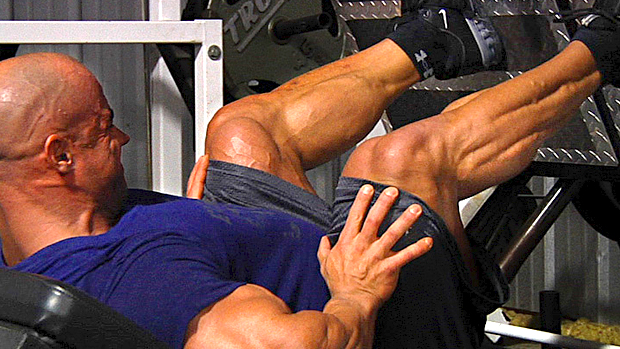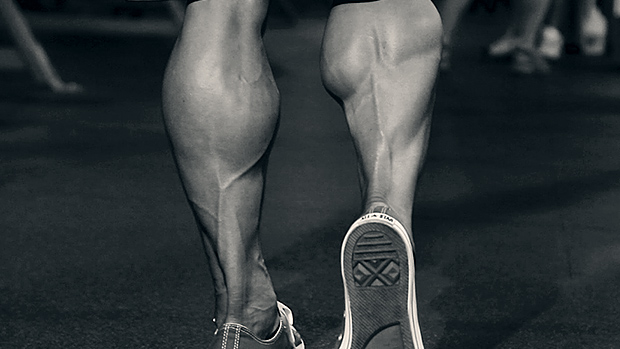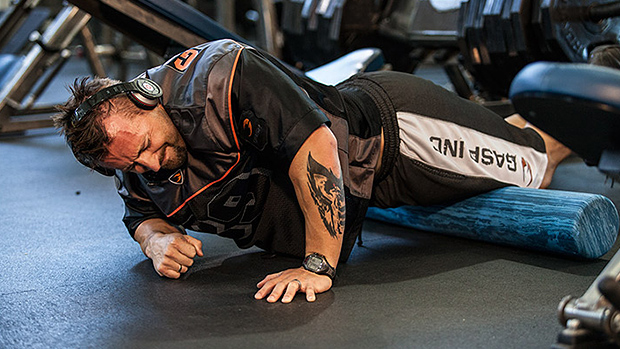The kettlebell swing is an incredible exercise, but it's also polarizing. Strength coaches either love it or hate it. Some say it's a great tool for teaching proper hip movement and for conditioning the glutes and hamstrings. Others say you need heavier loads to induce adaptations.
I understand both sides. What some fail to realize is that the hip extension torque requirements of a lighter kettlebell swing can match that of a heavier clean or snatch due to the inherent arced motion of the kettlebell. You must absorb eccentric loading and then reverse the kettlebell forward and upward. In the case of the Olympic pulls, you simply accelerate the barbell upward and then catch it.
So, the argument suggesting that power outputs of swings can't match those of power cleans and snatches isn't accurate. You must take into account the resultant (horizontal and vertical) data.
But I agree with the premise that a 35-pound kettlebell won't do much for hip strength – heavier loads are indeed needed as they lead to greater force production. But force isn't the only variable important in sports. Power is a critical component, and the swing is an excellent movement for hip power.
First I'd like to discuss kettlebell swing form. I'm sure the RKC folks have scrutinized every last detail about the swing and have come up with the best possible way of teaching it. And since I'm not RKC-certified, I'm not quite as qualified as those folks to discuss kettlebell swing form.
However, I'm obsessed with biomechanics and a student of movement in general. And for this reason, I know a perfect kettlebell swing when I see it. There's a certain beauty to the motion that's hard to describe.
Watch this video of my friend Marianne and you'll understand:
Here are some general rules you want to be aware of:
- A proper set up (sort of like a center hiking a football) is with high hips, a solid arch, and the kettlebell out in front to allow for proper "hiking" of the first rep.
- The feet stay planted firmly on the ground – there's no rising onto the toes.
- The movement's emphasis isn't on sinking down into a squat, but rather on hinging around the hips. There's a considerable range of motion around the hip joint with the torso position nearly parallel to the ground at the bottom range of motion.
- On the way down, the lifter shifts his weight forward a bit and the knees bend and travel forward slightly. On the way up, an explosive hip action characterized by a strong gluteal contraction raises the kettlbell upwards and the lifter shifts his weight backward a bit.
- While the kettlebell is near the body, it stays close to the "privates" and never sinks below the knees.
- A neutral spine (no lumbar flexion at the bottom or hyperextension at the top of the movement) position is maintained with very slight anterior pelvic tilt at the bottom of the motion and very slight posterior pelvic tilt at the top.
- The posterior pelvic tilt and glute contraction is maintained while the kettlebell travels upward and away from the body and is held until the kettlebell drops back down and returns near the body.
- There's no excessive contribution from the arms; for the most part the hips drive the kettlebell to its peak height, which is around shoulder-level.
- A neutral neck position (no cervical hyperextension) is maintained throughout the movement.
- The goal isn't to learn how to use momentum and conserve energy – it's easy to figure out how to "cheat" during the swing. Rather, the goal is to achieve a maximal glute contraction to drive the kettlebell forward and upward explosively while adhering to excellent technical form.
I'll Show You Someone Who Can Squat, Deadlift, and Hip Thrust Properly
Talk to any coach or trainer and they'll tell you some horror stories about "nightmare" athletes or clients who showed up on their doorsteps with the worst lumbopelvic-hip-complex (LPHC) kinematics known to mankind.
I've trained a few of these folks myself. They're unable to keep a neutral spine while bending. Tell them to sit back and they coil over like a snake. They don't possess the motor control to stabilize the spine while moving solely around the hip joint. It can take weeks just to get them to hip hinge properly. With these clients, you must improve their movement patterns before loading them up, so patience is needed.
For this reason, when someone shows up to train with me and they have proper kettlebell training experience, I'm ecstatic. If they can swing properly, it's quite easy to teach them how to squat, deadlift, and hip thrust properly.
They already possess superior motor control in the LPHC characterized by proper hip hinging form and proper gluteal contraction at lockout. These qualities exemplify most of the more complex components of the big lower body lifts.
Think about the typical cues used by coaches during squats and deadlifts: "Sit back," "knees out," "chest up," "push through the heels," "squeeze the glutes," and "keep the neck in neutral." Good kettlebell swingers are already doing all of these.
An Incredible Deadlift and Olympic Lift Assistance Exercise
When an assistance lift works, you know it immediately. I never got any "assistance" from swinging light kettlebells around. However, several months ago I bought a 106-pound kettlebell, and more recently a 203-pound kettlebell.
I should mention that my form on kettlebell swings is far from optimal. I look like a damn Neanderthal heaving the weight around. But I know how to use my glutes properly (from 6 years of hip thrusting) and therefore I fire them like crazy during the swing.
I've found that it's easy to swing 70 pounds with perfect form, but when you go heavier, it's a different story. Eventually I'll make the 203-pounder look right, but in the meantime it still provides an amazing training stimulus.
I'm not nearly as eloquent as Marianne, but nevertheless I've found that the transfer to deadlifting is incredible as long as you go heavy. At first, "heavy" for a typical female lifter might be 35 pounds and for a typical male, 70 pounds.
However, over time, fit females want to strive to swing 106 pounds for reps and males should shoot for 203 pounds. This may seem far-fetched, but it's a long-term goal to strive for.
In the video above, I'm swinging the 203-pounder for 8 reps. Two weeks later I got 20 reps with it, so your strength and power will rapidly increase when you start taking swings seriously. Now my 106-pounder feels like a cupcake.
Best still, heavy swings don't destroy the body like maximal deadlifts do, so you can train them more frequently. In fact, you can put deadlifts on the backburner for a while and maintain your strength by doing heavy ass swings 2-3 times per week.
When I was in Auckland, New Zealand, I conducted a minor experiment. I used two different loads (70 pounds and 140 pounds) and performed two different styles of swings (a squat style swing and a hip-hinge style swing) while standing on a force plate.
To the naked eye, the differences in form between the two appear very subtle, but in terms of kinematics and kinetics they're quite different. In the squat style, the kettlebell sinks down more, the knees bend more, and the torso stays slightly more upright, but in the hip style swing, the emphasis is on hip hinging (see Marianne's hip range of motion).
| Style | Load (lbs) | Peak Vertical Force (N) | Peak Horizontal Force (N) |
|---|---|---|---|
| Squat Style | 70 | 2,170-2,349 | 166-182 |
| Squat Style | 140 | 2,431-2,444 | 278-353 |
| Hip Hinge Style | 70 | 1,935-2,140 | 340-402 |
| Hip Hinge Style | 140 | 2,325-2,550 | 499-520 |
Heavy Hip Dominant Swings, Horizontal Force Production, and Sprint Speed
As you can see by the chart, the hip-hinge style swing generates much more horizontal forces than the squat style swing due to the more aggressive hip action. In fact, with the heaviest loads, you not only get more vertical force production, but you get 50% more horizontal force production, which is very significant.
Elite sprinters are able to generate large amounts of net horizontal force at high velocities, and faster speeds are all about the hips, so it's logical to assume that rapid, forceful kettlebell swings done in an RKC-style fashion would help sprinters attain greater speeds.
In fact, the 140-pound swing (I needed to hold onto two 70-pounders to use this load) leads to similar levels of horizontal force than those seen during maximal sprinting by elite sprinters.(1) And many researchers feel that horizontal force production and horizontal power are the keys to increasing speed.(2,3)
Two excellent studies have been published on muscle activation during the kettlebell swing. The first was conducted by Stu McGill and Leigh Marshall (4) and was published in January 2012, the second by Kreutzfeldt Zebis and colleagues (5) and was published ahead of print in July 2012.
McGill's study used a 16-kilogram (35-pound) kettlebell in the study, while Kreutzfeldt Zebis's study used either 12-kilogram (26-pound) or 16-kilogram (35-pound) kettlebells. The chart below summarizes the two study's findings.
| Muscle | Peak Activation (% MVC) |
% of Movement Cycle at Peak Activation | Hip Joint Angle at Peak Activation | Knee Joint Angle at Peak Activation |
|---|---|---|---|---|
| Gluteus Maximus | 76 | 57 | – | – |
| Gluteus Medius | 70 | 56 | – | – |
| Semitendinosus | 115 | – | 72 | 7 |
| Biceps Femoris Long Head | 93 | – | 70 | 7 |
McGill also included a case study on Pavel Tsatsouline in his study, and using a 32-kilogram (70-pound) kettlebell, Pavel was able to achieve 100% peak muscle activation in the gluteus maximus and over 150% peak muscle activation in his erector spinae.
I wish Stu would've reported the compressive and shear forces on the spine during Pavel's swings as this would be interesting to know. The average spinal loading was reported for the other participants and values were very high considering the weight of the kettlebells. These folks weren't nearly as experienced as Pavel at swings, nor were they using as heavy of loads, so undoubtedly the compressive (and likely the shear) loads were much greater in Pavel's case study.
One good thing I've noticed over the last year is that we're seeing a huge influx of kettlebell studies in the literature. However, these studies aren't very meaningful to me.
Imagine if you started seeing tons of studies on dumbbells but the studies only used 10 and 20-pound dumbbells with grown men. You'd be thinking, "Silly researcher, use heavier loads." Well, that's what I'm seeing in kettlebell research – incredibly light loads for the hips!
Interestingly, a recent study published ahead of print by Lake & Lauder used up to 70 pounds and this is one of the best studies I've seen to date (it showed that swings elicited a greater impulse than squats or jump squats), but this is the exception, not the norm.(6)
And 70 pounds still isn't all-that. I want to see training studies using heavy-ass kettlebells to see their transference to athletic performance. Check out my thoughts here on a recent study comparing kettlebells to Olympic lifting by Otto et al. – a poorly designed study, in my opinion.(7)
I realize that lighter kettlebells are common because people want to clean them, snatch them, press them, and do Turkish get-ups with them. And initially, lighter kettlebell loads are warranted in the swing.
However, as athletes and clients advance in kettlebell swings, you must progress them in load. I know most gyms and athletic facilities don't carry heavy-ass kettlebells, so I'm calling for action here!
Fitness equipment manufacturers need to start mass-producing heavy-ass kettlebells, and lifters, coaches, and gym owners need to start buying them. At the end of this article I'll provide several options that allow for heavy swinging.
Pelvic Positioning During the Swing
I obtained the quote below from Pavel Tsatsouline.(8) It's actually a quote from two legends in our field, Yuri Verkoshansky and Mel Siff. What made me so happy was that I came to this conclusion on my own without ever seeing this quote.
The pelvis plays a vital role in the ability of the athlete to produce strength efficiently and safely, because it is the major link between the spinal column and the lower extremities a neutral pelvic tilt offers the least stressful position for sitting, standing and walking. It is only when a load (or bodymass) is lifted or resisted those other types of pelvic tilt become necessary. Even then, only sufficient tilt is used to prevent excessive spinal flexion or extension The posterior pelvic tilt is the appropriate pelvic rotation for sit-ups or lifting objects above waist level. Conversely the anterior pelvic tilt is the correct pelvic rotation for squatting [and] lifting heavy loads off the floor. - Verkoshanksy and Siff 2009
If you adhere to this properly during a swing, you'll feel the hammies when in a hips flexed position (at the bottom ROM of the swing) and glutes when in a hips-extended position (at the top ROM of a swing).
I've never encountered a client who couldn't tolerate a kettlebell swing. I feel that they're generally well tolerated by the masses. However, there are indeed folks who might experience back pain or discomfort with swings. Stu's study showed that even when cued to move at the hips and keep the spine in neutral, many subjects indeed flexed and extended their spines.
Here, practice makes perfect. As you can see in the video of Marianne, her spine doesn't appear to flex or extend. Nevertheless, if you do experience pain or discomfort in the swing, make sure you swivel at the hips and keep the core and glutes tight.
One interesting gem I learned from Stu in a recent lecture was that the very top portion of the swing, where the kettlebell reaches its apex, poses the greatest risk to the spine.(9) At this moment, the core musculature relaxes and therefore compressive force diminishes.
Unfortunately, this compressive force is protective and limits shear forces, so at the same time the kettlebell is reaching its apex, it's also pulling the body forward, creating shear forces on the spine. And without the core muscle activation, compressive protection from shear isn't there. For folks who are intolerant to shear forces, this spells trouble.
Stu's latest kettlebell study showed that the swing imposed 3,195N of compressive force and 461N of shear with only 35-pound kettlebells, indicating that they might be problematic for some lifters.(4) And these figures would surely be much higher during heavier swings. So don't just jump full-bore into heavy swinging – ease into it.
Are Kettlebell Swings for Pussies?
I'll keep this brief. Many meatheads say that kettlebell swings are a sissy exercise. However, Jim Wendler approves them (10), and Jim has squatted a grand and has a huge beard. Enough said! I'm sure he'd like them even more if he had a 203-pounder to throw around. Heavy swings are not a sissy exercise, trust me!
Heavy Swings A Permanent Replacement for Dynamic Effort Deadlifts?
After performing heavy swings for a solid month, I no longer see any need to perform dynamic effort deadlifts. The heavy swing is a superior movement in my opinion.
First, you get more hip range of motion. Second, the double overhand grip provides a great challenge to the grip. And third, there's a greater acceleration phase with the swing as it's really a ballistic movement; by law the dynamic deadlift must decelerate to come to a halt.
In fact, I like the heavy swing better than the Olympic lifts and jump squats for football players – it's simpler to teach and easier on the joints. Down the road I'd like to see college football and NFL teams taking heavy swings seriously.
There are four options for heavy swinging:
1. Homemade T-Handle
You can make your own homemade T-Handle. I made mine for under $15 after I first read about it online.(11) All you need from your local hardware store is the following:
- One 3/4-inch pipe Tee fitting
- One 3/4-inch floor flange
- Two 3/4-inch x 4-inch pipe nipples for the "horns," or better, one 3/4-inch x 8-inch nipple cut in half
- One 3/4-inch x 12-inch pipe nipple for the vertical shaft (a pipe nipple is a piece of pipe, threaded at both ends)
Of course, you'll need some 25-pound plates to load onto the pipe as well. Here's what it looks like:
2. Hungarian Core Blaster
Second, you can buy a Hungarian Core Blaster.(12) This is better than the homemade version (T-Handle) so if you have the money, go for it.
3. The KettleClamp
Third, you can buy a KettleClamp. This is a new invention that essentially turns any dumbbell into a kettlebell.(13) Here's what it looks like:
4. Monster Kettlebells
Finally, you can simply buy heavy ass kettlebells.
My 106-pounder is from APOLLO, which I bought at a local fitness store, and my 203-pounder is from ADER, which I found on eBay. There are also companies selling them online.(14)
If you have the money, you should definitely go this route and buy the actual heavy kettlebells as they simply feel the best, but the Hungarian Core Blaster works very well too, as does the KettleClamp.
And with that, I shall wrap up this article that's ostensibly every damn thing you wanted to know about heavy kettlebell swinging. I hope you decide to take my advice and start implementing heavy swings, if so you'll thank me down the road. Please join me and become a proud swinger!
- Mann RA. The Mechanics of Sprinting and Hurdling. CreateSpace Independent Publishing Platform. 2011.
- Brughelli M et al. Effects of running velocity on running kinetics and kinematics. J Strength Cond Res. 2011 Apr;25(4):933-9.
- Morin JB et al. Technical ability of force application as a determinant factor of sprint performance. Med Sci Sports Exerc. 2011 Sep;43(9):1680-8.
- McGill SM et al. Kettlebell swing, snatch, and bottoms-up carry: back and hip muscle activation, motion, and low back loads. J Strength Cond Res. 2012 Jan;26(1):16-27.
- Zebis MK et al. Kettlebell swing targets semitendinosus and supine leg curl targets biceps femoris: an EMG study with rehabilitation implications. Br J Sports Med. 2013 Dec;47(18):1192-8
- Lake JP et al. Mechanical demands of the kettlebell swing exercise. J Strength Cond Res. 2012 Dec;26(12):3209-16.
- Contreras B. Olympic Weightlifting vs. Kettlebells on Lower Body Strength and Power. Feb 29, 2012.
- Tsatsouline P. Hardstyle Abs: Hit Hard. Lift Heavy. Look the Part. Dragon Door Publications. 2012 August.
- McGill S et al. From the Lab to the Trenches. Audio Lecture. MovementLectures.Com. August 2012.
- Krahn, B. Blood and Chalk Volume 4: Jim Wendler Talks Big Weights. March, 2010.

